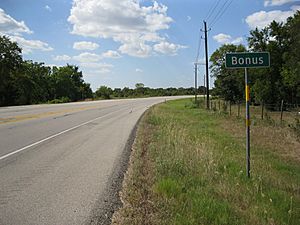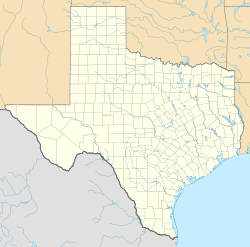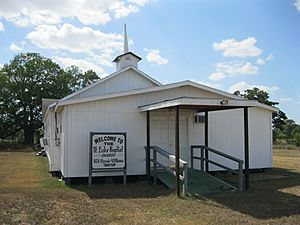Bonus, Texas facts for kids
Quick facts for kids
Bonus, Texas
|
|
|---|---|

Bonus sign is on FM 102
|
|
| Country | United States |
| State | Texas |
| County | Wharton |
| Elevation | 148 ft (45 m) |
| Time zone | UTC-6 (Central (CST)) |
| • Summer (DST) | UTC-5 (CDT) |
| ZIP code |
77434
|
| Area code(s) | 979 |
| GNIS feature ID | 1378031 |
Bonus is a small, unincorporated community in northern Wharton County, Texas, United States. It is located about 15 miles (24 km) north of the city of Wharton. You can find Bonus near where Farm to Market Road 102 and Farm to Market Road 2614 meet.
History of Bonus
The community of Bonus started in the mid-1890s. Its beginning was linked to the construction of the Cane Belt Railroad. The railroad line ended at a large plantation owned by W. L. Dunovant and William Thomas Eldridge. These two men were also involved in starting the railroad company.
In 1896, the community tried to get a post office and wanted to name it "Alamo." However, that name was not approved. The name "Bonus" was chosen because, it is said, the railroad owners were promised an extra payment, or "bonus," if they built the line into this area. The Bonus post office officially opened in 1896.
Dunovant and Eldridge brought many African American families to the area. These families worked on the farms, growing crops like cotton, corn, rice, and sugar cane. In its early years, Bonus had only a few White American residents.
Around the early 1900s, a labor camp was established in Bonus. People worked on the land and helped with farming under special agreements. In 1901, the business partnership between Dunovant and Eldridge ended. Eldridge took over the Bonus plantation, while Dunovant took another one. Sadly, in 1902, a serious disagreement between them led to a tragic event.
By 1936, Bonus had about 50 residents and two local businesses. The community's post office closed and reopened a few times before it finally closed for good in 1940. After that, people in Bonus received their mail from nearby towns like Eagle Lake and Egypt.
The rail line connecting Eldridge to Bonus stopped service in 1940. The old railroad path was then turned into a county road. In the 1980s, Bonus had 42 residents and no businesses were reported. The Cane Belt railroad service completely ended in 1992. This meant the tracks and other parts of the railway were removed. In 2000, the population of Bonus remained at 42 people.
Education in Bonus
Students in Bonus are served by the East Bernard Independent School District (EBISD).
In 1905, there was a school in Bonus specifically for African-American students. It had one teacher and 57 students. Later, this school joined with another small school called Nedra School, which was also for Black students. Together, they formed the Bonus-Nedra School.
By 1926, the school district in the area had four schools in total. These schools had four teachers, 75 White American students, and 110 Black students. In 1958, the Bonus school district combined with the Hungerford Independent School District. Finally, in 1973, the East Bernard Independent School District took over the land and schools in the area.
Notable Person
- Joseph Newman was an important early settler in Texas. He was part of Stephen F. Austin's group known as the Old Three Hundred. Newman owned a large ranch and farm area, called a sitio, located near Bonus.




